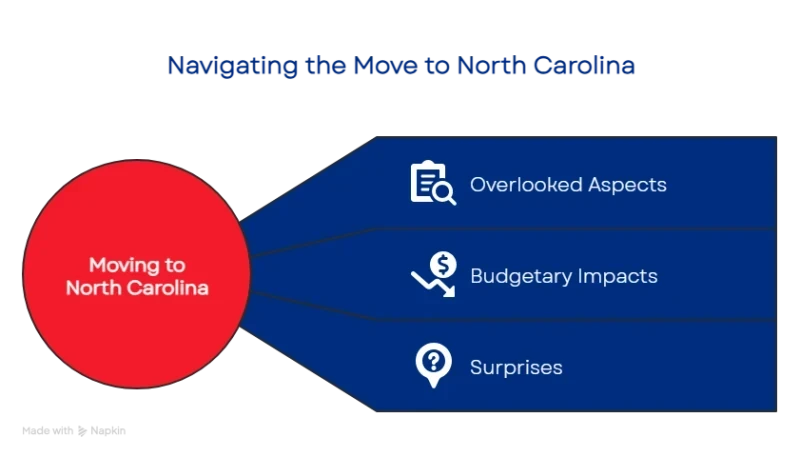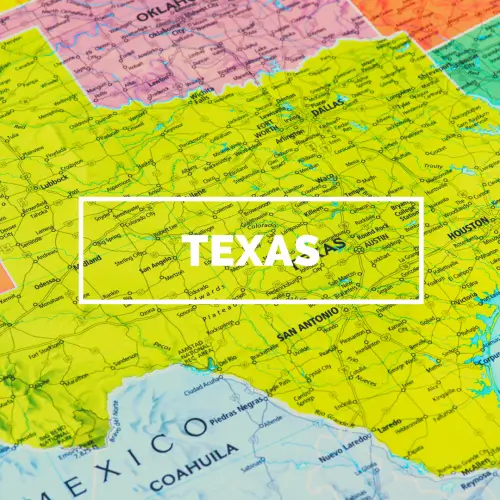Thinking about moving to North Carolina? Missing the right information can lead to high costs and added stress.
North Carolina added more than 100,000 new residents last year, according to 2024 Census Bureau estimates. Many arrived without a clear plan. Some faced higher-than-expected rent in North Carolina cities. Others dealt with unexpected weather conditions, including potential wildfires in North Carolina. A few picked the wrong region entirely for their lifestyle, not considering factors like proximity to the capital of North Carolina.
This guide will help you avoid those problems. It covers what new residents often overlook, what can impact your budget, and how to move with fewer surprises.
What You’ll Learn
Which part of the state fits your lifestyle: mountain, coast, or city
What it really costs to live here
What surprises most new residents—and how to avoid those pitfalls
Summary
North Carolina attracts newcomers nationwide with its rapid growth, geographic diversity, and strong job market. If you’re considering a move, here are the latest essentials about the cost of living, housing, weather, and lifestyle to help you prepare.
1. Geographic Diversity: Mountains, Piedmont, and Coast
North Carolina offers three distinct regions: mountain towns (like Asheville), rolling Piedmont cities (Charlotte, Raleigh, Durham), and a relaxed coastline (Wilmington, Outer Banks). Each area has its own climate, job market, and lifestyle, so research before you pick a location.
2. Strong but Varied Job Market
The state’s unemployment rate hovers a bit below the national average, with nearly 300,000 job openings in spring 2025. Tech, finance, healthcare, and education are robust, especially in Raleigh (“Research Triangle”), Charlotte, and Durham.
3. Moderate Overall Cost of Living
North Carolina’s cost of living matches the U.S. average. Housing is about 14% lower than the national average, utilities are 2% lower, and groceries and transportation costs are roughly on par. Healthcare costs, however, run 4% above the U.S. average.
4. Housing is Affordable Except in Hot Markets
The median home price statewide is about $337,000 (mid-2025), with average rents around $1,360–$1,440/month. However, expect higher prices in Raleigh, Charlotte, Asheville, and resort areas; small towns and rural regions cost less.
5. Taxes are Middle-of-the-Road
NC’s 2025 flat income tax rate is 4.25% and drops to 3.99% for 2026. Combined state and local sales taxes average 6.75–7.5%. Property taxes are moderate, with an average effective rate of 0.7%. Social Security income isn’t taxed.
6. Weather: Hot Summers, Mild Winters, Storm Risks
Expect humid summers with temperatures in the 90s °F, mild coastal/mid-state winters, and snow only in the western mountains. The unpredictability stands out: rapid temperature swings, hurricanes along the coast, and occasional tornadoes statewide. Keep a hurricane kit if you’re coastal and a flexible wardrobe for sudden weather changes.
7. Education is a Standout
North Carolina boasts major universities (UNC, Duke, NC State), respected K-12 and charter schools, and a network of community colleges, particularly strong in urban and suburban centers.
8. Growing, Diverse, Welcoming Communities
Raleigh, Charlotte, and Durham are melting pots attracting people from around the U.S. and the world, offering active art, food, and music scenes as well as a blend of Southern hospitality and urban vibrancy.
9. Outdoor Lovers Thrive
The Blue Ridge and Smoky Mountains offer hiking, camping, and scenic drives, while the Atlantic coast is renowned for fishing, boating, and beach life. State parks are abundant, and the climate supports year-round outdoor activity.
10. Urbanization Equals Traffic and Opportunity
Charlotte and Raleigh are growing fast, so expect new construction and congestion, especially at rush hour. Public transit is expanding, but most people still depend on cars, and commutes can be lengthy in the largest cities.
Bonus Tips
Healthcare Access: Healthcare is widely available, but costs a bit above U.S. norms and the best quality is found in metro areas.
Culture: Sports pride is intense (especially for basketball and college football), breweries and local food scenes are booming, and music and festivals dot the state.
Four Seasons: Enjoy all four seasons, but be ready for humidity and storms in summer and variable weather year-round.
North Carolina combines affordability, career opportunity, natural beauty, and Southern friendliness, but costs and climate vary by region, and growth is bringing both amenities and challenges. Do your research, visit neighborhoods, and plan for weather, taxes, and commuting before you move.
North Carolina Is Not One Place
The state is divided into three main regions. Each offers a distinct lifestyle.
Think of it like choosing between three homes. One sits in the mountains with cooler air and quiet roads. One is in the center with fast-growing cities and steady job options. One is on the coast where the pace slows and the ocean shapes daily life.
Each place has a different feel, cost, and climate. Picking the right one makes a big difference.
1. Geographic Diversity: Mountains, Piedmont, and Coast
North Carolina has three main regions. Each one has its own pace, climate, and cost of living.
Mountains: Cooler weather, smaller towns, and slower growth. Popular for hiking, privacy, and outdoor space. Housing tends to be more affordable in rural areas but is limited near tourist towns like Asheville.
Piedmont: Includes cities like Charlotte, Raleigh, and Greensboro. Fast-growing job markets, higher traffic, and more housing demand. Summers are hot, winters are mild, and options for work and school are strong.
Coast: Warmer year-round. Higher risk of hurricanes. Known for beaches, military towns, and tourism. Housing prices vary, with some coastal towns becoming more expensive due to second homes and rentals.
Lifestyle depends on location. Mountain areas offer quiet. Cities bring more activity and access. Coastal regions appeal to those who want to live near the water.
2. Strong But Varied Job Market
Job opportunities in North Carolina depend on location and industry. Larger cities attract more employers, but some rural areas have limited options.
Technology: Raleigh and Durham are part of the Research Triangle, home to major tech firms and startups.
Healthcare: Hospitals and health systems are among the state’s largest employers. Demand is high across regions.
Finance: Charlotte is one of the country’s biggest banking hubs.
Education: Universities and public schools offer steady work in both urban and suburban areas.
Remote work is common in tech and professional services. Internet access and the cost of living can affect where remote workers choose to live. Some rural areas have fewer service providers or slower speeds.
Before moving, check local job listings by city or county. Industry strength shifts across the state.
3. Moderate Overall Cost Of Living
North Carolina’s cost of living is close to the national average. What you spend depends on where you live and how you budget.
Housing: Urban areas cost more. Rural towns and suburbs offer lower prices but may have fewer options.
Utilities: Monthly utility bills often fall between $150 and $250, depending on home size and location.
Groceries: Prices are stable but slightly higher in tourist zones and remote areas.
Transportation: Gas prices are average. Most people need a car, especially outside major cities.
Your money goes further in smaller cities and rural counties. In higher-growth areas like Charlotte or Raleigh, wages tend to match higher costs, but demand affects pricing.
Check local averages for rent, insurance, and food before finalizing your move.
4. Housing Is Affordable Except In Hot Markets
Housing prices in North Carolina are still lower than in many other states, but demand in key areas is driving costs up.
The median home price in 2025 is around $337,000.
Monthly rent for a typical apartment falls between $1,360 and $1,440, depending on the city.
Urban centers like Raleigh, Charlotte, and Asheville have seen the biggest price increases. Buyers face competition, and homes sell quickly. Renters in these areas often pay more and may need to act fast to secure a lease.
In rural areas and smaller towns, homes stay on the market longer. Prices are more stable, and rental availability is higher.
If you plan to buy, get pre-approved early. If you plan to rent, start your search at least 60 days before your move.
5. Taxes Are Middle-Of-The-Road
North Carolina keeps tax rates simple, but amounts owed still depend on income, property value, and spending habits.
State income tax is a flat 4.25 percent in 2025. It is scheduled to drop to 3.99 percent in 2026.
Sales tax ranges from 6.75 to 7.5 percent, depending on the county.
Property tax is below the national average. Rates vary by county and home value.
Retirees benefit from state tax policy. Social Security income is not taxed, and other retirement income may be taxed at the flat rate.
6. Weather: Hot Summers, Mild Winters, And Storm Risks
North Carolina has four seasons, but conditions change based on location.
Summer: Hot and humid. Highs often reach the 90s, especially in the Piedmont and coastal regions.
Fall: Mild temperatures with more dry days. Leaves change early in the mountains.
Winter: Light snow in the Piedmont. Coastal areas stay above freezing. The mountains get regular snow and ice.
Spring: Rainy and unpredictable. Thunderstorms are common, especially in central and eastern parts of the state.
Storm risks vary by region.
Hurricanes can affect the coast between June and November.
Tornadoes are more likely in spring, mostly in the central and eastern parts of the state.
Ice storms are a concern in the west and central regions during winter.
Before you move, check the weather trends in your target area. It helps with planning home features, clothing, and insurance needs.
7. Education Is A Standout
North Carolina has a strong mix of public schools, charter options, and major universities.
Higher education includes well-known schools like UNC-Chapel Hill, Duke University, and NC State. These universities support research, healthcare, and job training.
Public schools vary by district. Urban and suburban areas often offer more programs and updated facilities.
Charter and magnet schools give families more options in certain counties. Availability varies by location.
If education is a priority, review school ratings by district before choosing a location. University towns often bring added benefits, like access to events, libraries, and healthcare systems.
8. Growing, Diverse, Welcoming Communities
North Carolina’s population is rising, and with that growth comes more cultural variety and local engagement.
Cities like Raleigh, Charlotte, and Durham have seen rapid growth in new residents from other states and countries.
Cultural events are part of daily life. Food festivals, art walks, and live music are common in both large and mid-sized cities.
Neighborhoods often combine longtime locals with newcomers, creating a mix of backgrounds and experiences.
Diversity is growing across age, race, and profession. While some towns remain more traditional, larger cities now reflect a wide range of perspectives and community activities.
9. Outdoor Lovers Thrive
North Carolina offers easy access to nature in every region of the state.
Western areas include the Blue Ridge and Smoky Mountains, with trails for hiking, biking, and camping.
The coast has public beaches, fishing piers, and spots for kayaking and boating.
State parks and forests are spread across the state and remain open year-round.
Outdoor activities are part of daily life for many residents. Whether it’s a short walk or a weekend trip, nature is accessible without long drives or special equipment.
10. Urbanization Equals Traffic And Opportunity
North Carolina’s cities are growing fast. Growth brings more jobs, housing, and services but also more traffic.
Charlotte and Raleigh have seen the most population growth and construction activity.
Commute times are increasing, especially during peak hours. Public transit is available but limited outside of core routes.
New development includes mixed-use projects, road expansions, and retail centers.
Most people still rely on cars. If you plan to work in a city center, check commute times from surrounding neighborhoods. Growth brings access to new jobs and services, but planning around traffic helps keep your schedule manageable.
Final Thoughts
Moving to North Carolina brings real advantages. Living costs are manageable, cities are expanding, and outdoor opportunities are built into daily life. But every region offers something different.
Learn as much as you can before you commit, and compare housing prices, climate, and local services. Review schools, road conditions, and job availability by zip code.
A clear plan helps reduce stress and avoid extra costs.
Need Help Shipping Your Car?
If you're moving to North Carolina and need to transport your vehicle, AmeriFreight Auto Transport can help. We work with licensed and vetted carriers to arrange reliable vehicle transport nationwide.
We help guide you through the process from pickup to delivery.
Frequently Asked Questions (FAQs)
How often do hurricanes impact coastal North Carolina cities like Wilmington or the Outer Banks?
These areas face hurricane risks each year from June to November. Some seasons are quiet, others bring major storms.
Which North Carolina cities offer a good balance of outdoor activities and cultural attractions?
Asheville, Raleigh, and Durham all offer trails, parks, music, food, and access to the arts in one location.
Does North Carolina experience much snow in the winter, especially in the mountains versus the coast?
Yes, in the mountains, sometimes in the Piedmont, and rarely on the coast.
What are the common pests or wildlife issues residents might encounter in North Carolina?
Mosquitoes, ticks, and snakes are the most common. Risk is higher in rural or wooded areas.
Disclaimer: This guide is for general information only and does not provide legal, financial, or tax advice. Always consult a licensed professional before making decisions related to relocation, housing, or vehicle transport.
















